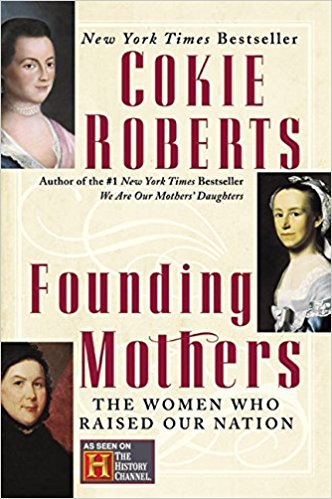Book Review: Founding Mothers, The Women Who Raised Our Nation
Founding Mothers, The Women Who Raised Our Nation
Cokie Roberts (Harper Collins 2004)
Reviewed by Gina Vizavi
 When Cokie Roberts’ book Founding Mothers first came out I read the reviews and thought what an interesting concept for a book. And when a copy finally landed on my nightstand I was drawn in from page one.
When Cokie Roberts’ book Founding Mothers first came out I read the reviews and thought what an interesting concept for a book. And when a copy finally landed on my nightstand I was drawn in from page one.
What I found so compelling about this book is that stories are told through letters of correspondence then woven by Cokie’s narrative which ties together the “Who’s Who” of the story: as in, who shared family ties through marriage that might escape a textbook version of events. She is a wonderful story teller and her asides following quotes often clarify them, adding context and frequently humor.
I have always found reading a diary or letters from the past, in someone’s own words, to be much more vivid than an academic interpretation. Their quotes give us a window into their minds. It’s fascinating to me, to see their use of language, and words to convey imagery.
Reading the accounts of these women paints a picture of what their lives were like: child birth, infant and child mortality, long absences of spouses and children being separated oceans away, financial challenges, not to mention the horrors of war.
Under a system called “couverture,” women had no legal rights and husbands basically owned their wives. Judith Murray who became famous for articles she wrote claimed the Revolution had caused her to think about women’s roles in America lamenting “The lawyers acknowledges no separate act of a married woman.”
In 1774 the Virginia Gazette published “A Lady’s Adieu to Her Tea Table” because “Its use will fashion slavish chains upon my country.” The same year the ladies of Edenton, NC met to sign an agreement to boycott British tea and cloth. And it is said women could be found among the mobs tarring and feathering merchants who defied the boycotts.
The book discusses the changing roles for women during this time, particularly women advocating for educating girls and young women. In the section entitled “Ladies of Letters” we see Catharine Macaulay publishing her Letters on Education (1790), the same year Massachusetts Magazine printed Judith Sargent Murray’s poem and essay “On Equality of the Sexes.”
Mercy Warren anonymously wrote satirical plays and poems pillorying British sympathizers and their leaders which were popular, widely read, and swayed public opinion to the patriot’s cause. Poems, Dramatic and Miscellaneous (1790) was the first work published under her own name. Alexander Hamilton wrote of it, “In the career of dramatic composition at least, female genius in the United States has outstripped the male.” Two years later British author Mary Wollstonercraft’s Vindication of the Rights of Women which undoubtedly started giving women “ideas.”
The following year Priscilla Mason gave the “Salutary Oration” to the graduates of the Ladies Academy of Philadelphia in which she railed: “Our high and mighty lords (thanks to their arbitrary constitutions) have denied us the means of knowledge, and then reproached us for the want of it.” Then asked where a female orator such as herself could use their talents: “The Church, the Bar, the Senate are shut against us. Who shut them? Man; despotic man, first made us incapable of duty, then forbid us the exercise. Let us by suitable education, qualify ourselves for these high departments. They will be open before us.”
An inspiring character is found in Eliza Pickney who at 16 found herself in South Carolina with her father bound for Antiqua leaving her to care for an ailing mother and toddler sibling and manage three plantations. During which time she experimented with growing indigo, making it another cash crop for South Carolina. In her twilight years, she even is credited with helping Eli Whitney invent the cotton gin.
Despite the fact that Ben Franklin had the title of Postmaster during many years of cavorting in France, it was his wife, Deborah who did the work. Of course, Abigail Adams is prominent throughout the book, thanks to a great number of surviving letters that she wrote as well as those of the many influential people to whom she wrote. One quote by her husband was his advice to daughter Nabby,“It is by the female world that the greatest and best characters among men are formed.”
A picture of Martha Washington emerges that is seldom seen. Aside from being much older than George, she did much during the war and during his presidency to ensure success of our new nation. That included leaving Mount Vernon in mid-winter to join her husband at camp in New Jersey. One regiment styled itself as “Lady Washington’s Dragoons” wearing white uniforms trimmed in blue.
We get glimpses of some of the fancy dinners and balls being held and hear snippets of conversations, who was dancing with whom and descriptions of the fashions of the day. And for those who love to cook there is a special chapter devoted to some period recipes. Cokie states, “I’ve decided not to dress a whole head of cow, but Hearty Choke Pie is delicious.” And of course her extensive annotated footnotes at the back of the book provide even more titles of interest.
I heartily recommend this to anyone who has an interest in American History and Herstory and for those looking for strong women to admire.
Founding Mothers is available from Amazon.
Category: Product Review, Transgender History










